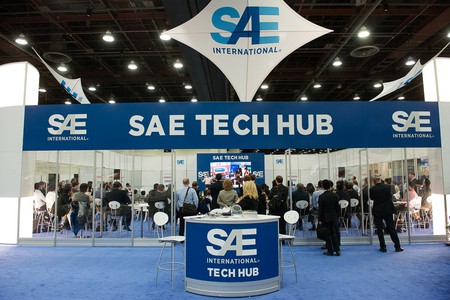 At SAE World Congress this week in Detroit, there were announcements both good and bad for the connected car industry from the feds, Toyota, suppliers, GM and engineers.
At SAE World Congress this week in Detroit, there were announcements both good and bad for the connected car industry from the feds, Toyota, suppliers, GM and engineers.
Toyota’s Gift to STEM
Toyota announced a gift of $1 million to strengthen and expand access to “A World in Motion,” (AWIM), the Society of Automotive Engineers’ high-quality science, technology, engineering and math (STEM) education program.
Toyota’s investment also supports the AWIM “LearnTwice” initiative” by creating a pathway for university students to participate in AWIM classrooms throughout the U.S.
Self-Driving Cars Are a Threat to National Security/Safety?
 At SAE World Congress, John Carlin, the assistant US attorney general for national security voiced concerns that terrorist could use self-driving cars for threats and attacks.
At SAE World Congress, John Carlin, the assistant US attorney general for national security voiced concerns that terrorist could use self-driving cars for threats and attacks.
“Within each of those cars will be hundreds of different systems, each essentially computers in the car, and connected wirelessly,” he said. “What we can see based on the threats we’ve seen in other industries and other areas is those who oppose our values — be they rogue nation states or terrorist groups — are looking to exploit this change in technology.
He noted that there is no internet-connected system where you can build a wall that’s high enough or deep enough to keep a dedicated nation-state adversary or a sophisticated criminal group out of the system.”
New Class of Glass
Pittsburgh Glass Works showed advances in lightweight glazing and solar control for automotive glass to help automakers meet global emissions and fuel economy standards.
By using new thinner glaze glass compositions such as those offered by PGW in a vehicle’s windshield, sunroof, side windows and rear window, automakers can see a weight reduction of up to 20kg over standard glass while maintaining performance.
In addition, PGW utilizes Infra Red (IR) reflective technologies in its solar glazing to help reduce the thermal load through the glass, which reduces the use of air conditioning. The latest technology from PGW will enable automakers to claim the maximum allowable off-cycle emissions credits for glazing from the U.S. Environmental Protection Agency.
Pittsburgh Glass was shown on the Ford GT Supercar and the Tesla Model X.
New Plugin Car that Plugins to Gen-Z & Has It’s Own Electrical Outlets
 Toyota and Clemson University unveiled a new all-electric concept car “uBox.” Designed, engineered and hand-built by graduate students at Clemson University’s International Center for Automotive Research (CU-ICAR), the vehicle is the result of a two-year collaboration with Toyota Motor North America designers and engineers. The result is an innovative, flexible concept called uBox that is intended to appeal to the next generation of car buyers: Gen-Z.
Toyota and Clemson University unveiled a new all-electric concept car “uBox.” Designed, engineered and hand-built by graduate students at Clemson University’s International Center for Automotive Research (CU-ICAR), the vehicle is the result of a two-year collaboration with Toyota Motor North America designers and engineers. The result is an innovative, flexible concept called uBox that is intended to appeal to the next generation of car buyers: Gen-Z.
Some of the many features of uBox include, reconfigurable, removable seats on sliding tracks that can be nested. Personalized vents, dashboard display bezels and door trim using 3-D printing technology, and an online community for owners where they can share design ideas. It features compact, dual-purpose, all-electric powertrain providing a fun driving experience and emission-free stationary energy to power consumer electronics, power tools or other devices through various 110-volt sockets located throughout the interior and exterior.
Detroit vs. Silicon Valley
GM’s Dan Nicholson while promoting Chevrolet Bolt electric car when he took a jab at some of the expected problems with the Tesla 3.
“I am very proud of the Chevrolet Bolt that’s coming out, which will be the first to market as a long-range affordable battery electric vehicle,” Nicholson said,. “It will have more than 200 miles of range and it will be in production by the end of 2016, so it’s not necessary to put down $1,000 and wait until 2018 or some time after that.”
Standard Messaging Rates Apply
On the other side of the self-driving development fence are the standards needed for cars to talk to each other.
SAE International has published two new technical standards that standardize the data message sets used in Vehicle-to-Vehicle (V2V) communications and establish the parameters for a vehicle communication system to receive and transmit the message sets.
These standards allow automoakers and other developers to build interoperable V2V systems that will ensure that vehicles from different manufacturers are able to successfully communicate with each other.
“V2V technology is an important and growing safety technology for future vehicles,” Jack Pokrzywa, Director of Ground Vehicle Standards for SAE International, said. “These new standards establish the parameters on how vehicles communicate with each other, thereby improving their safety effectiveness by designing interoperable systems.”
SAEJ2735 – Dedicated Short Range Communications (DSRC) Message Set Dictionary is the fifth edition of the message set dictionary and specifies a message set, and its data frames and data elements specifically for use by safety applications intended to utilize 5.9 GHz DSRC for V2V communication systems. This standard also supports interoperability among DSRC applications through the use of a standardized message set, and its data frames and data elements. Common and interoperable message sets are the cornerstone of V2V safety applications.
SAE 2945/1 – On-Board System Requirements for V2V Safety Communications is the first edition of on-board system requirements for V2V safety communications and specifies the parameters for a system to transmit and receive the SAE J2735TM-defined safety messages over a Dedicated Short Range Communications (DSRC) wireless communications link. It also ensures that the exchange of safety messages in V2V safety communications provides the desired interoperability and data integrity to support the performance of the envisioned safety applications and provides the information necessary to build interoperable systems that support select safety applications.
It is expected that both standards will be cited in the National Highway Traffic Administration’s (NHTSA) upcoming Federal Motor Vehicle Safety Standard Number 150 (FMVSS 150) rulemaking which will require vehicle-to-vehicle (V2V) communication capability for light duty vehicles and create minimum performance requirements for V2V devices and messages.